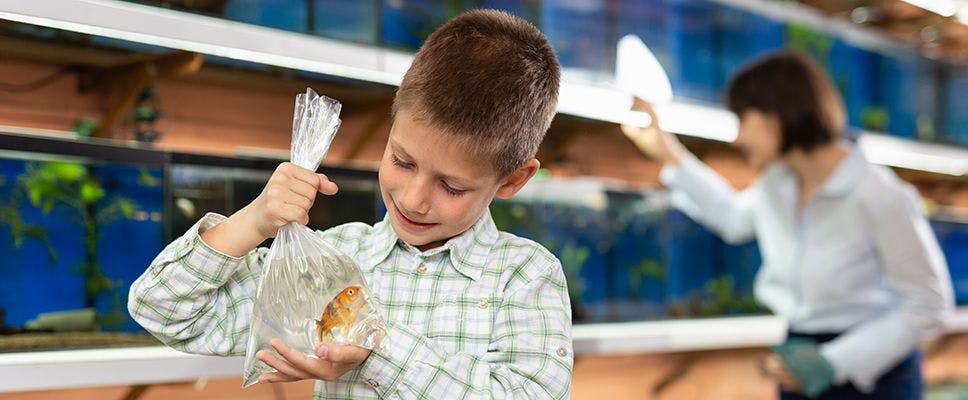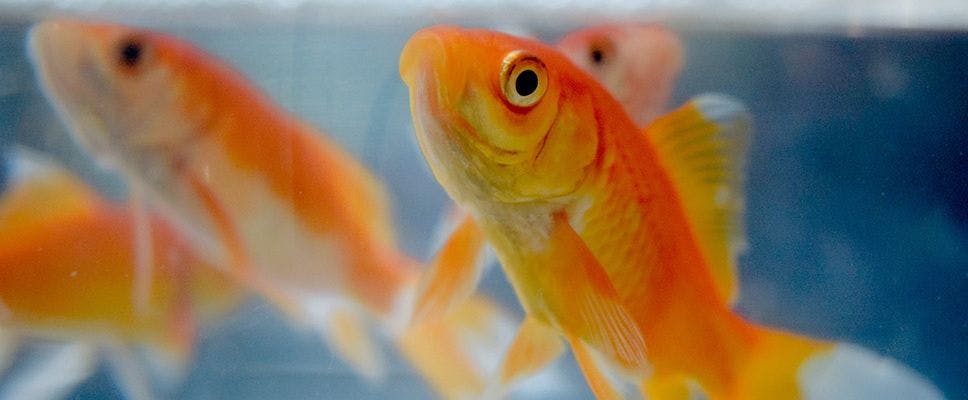
Fish make great pets! They can be relatively low maintenance and inexpensive and there are a variety of different breeds to choose from. There are a few things to consider before you bring a pet fish home though – from what types of fish to get, to how to set up a tank and what to feed your fish – we’re here to help.
Should I Get A Pet Fish?
Before bringing any animal into your home, you need to consider if it’s right for you and your family. Like any pet, a fish is a commitment, and you need to be willing to provide the care it needs to thrive in its new environment.
The good news is fish are relatively easy to care for: they’re largely independent (aside from feeding them and cleaning their tank they don’t require much attention), plus they don’t make noise or need much space making them ideal pets for apartments. When well looked after, they can live for a long time (a goldfish for example has an average lifespan of 10-15 years), so depending on the type of fish you choose they can be a long-term commitment.
There are many more benefits to owning a fish. These include:
- Caring for pet fish is a great family activity, and good practice to work towards more demanding and time-consuming pets like dogs and cats.
- For families, owning a fish helps teach children care and responsibility – and it can inspire a greater interest in nature and the environment.
- Aquariums are visually striking and liven up the room they’re placed in. They’re also fun to tinker with and improve over time – allowing fish ownership to develop into a rewarding hobby.
- Watching fish swimming in their tank has a calming effect – studies have shown that owning fish can even help reduce anxiety and stress…this is why you sometimes see them in dentist’s waiting rooms!
Types Of Pet Fish
If you decide fish ownership is for you, you’ll need to consider what kind of fish you want to get. There are two options for domestic pet fish: cold or tropical water fish. Each has unique requirements and characteristics – but it’s important you don’t mix fish with different water requirements in the same tank as it’s difficult to create conditions that both types of fish can thrive in simultaneously.
Tropical Fish
Popular because of their brilliant colours and shapes, tropical fish give an exotic feel to your aquarium. If you want to keep tropical fish, you’ll also need to get a heater to ensure the water temperature is warm enough. Most tropical fish require water temperatures between 22-27 degrees Celsius.
Cold-Water Fish
Cold-water fish are great for first-time buyers and beginner pet owners because they tend to be more robust than tropical fish. They like temperatures below 22 degrees Celsius. You may still need to get a heater though, depending on the species.
Want to know more about choosing the right fish? Read about it here!

What Equipment Do I Need For A Pet Fish?
While fish are relatively easy to care for, they require a lot of preparation and equipment. Setting up your fish’s home will likely be the most time-consuming part of fish ownership – and it’s the first thing you’re faced with! Don’t worry though, PETstock has you covered. See the below checklist for all the essentials.
Pet Fish Product Checklist:
✓ Aquarium
✓ Aquarium gravel
✓ Aquarium filter
✓ Aquarium light
✓ Air pump
✓ Decorations
✓ Aquarium test kits
✓ Fish food
✓ Heater
✓ Gravel cleaner
✓ Fish net
✓ Magnet cleaner/scrubbing brush or sponge
✓ De-chlorinator
✓ Biological bacteria product
✓ PH neutral regulator/PH up or down
✓ Thermometer
✓ Other products may be required depending on type of fish you wish to keep. Come visit the team at PETstock, who will be able to provide information and recommendations about what further products you may need.
Adding live plants to your tank is a great way to kickstart the biological process.
How To Choose An Aquarium
Let’s get to the first item on the checklist: your aquarium. While it sounds simple, there are quite a few things to take into consideration when choosing an aquarium.
1. Location
This is important, as once your tank is set up it’s very difficult to move. You’ll need a space that’s in a room that gets used regularly so your tank is easy to view and enjoy (what’s the point of having a lovely fish tank that no one sees?). You should also set up your tank away from direct sunlight (as this can interfere with your water temperate and encourage algae to grow) but near a power point and not too far from a water source (this makes it easier to clean and maintain your tank). Once you’ve got an area picked out, consider how much space you’ve got to work with – ideally the bigger tank the better, but you don’t want to overcrowd your room.
2. Size
When it comes to aquariums, bigger is better. And yes, this is partly because it allows your fishy friends more space to roam, but it’s also because it’s far easier to maintain a larger tank. It sounds counterintuitive – surely a smaller space will have less upkeep? But this is a common misconception. In a smaller tank, uneaten food and the waste your fish naturally produces builds up quickly and produces toxic chemicals which rapidly become dangerous to your fish. Larger tanks require less regularly cleaning as they boast more stable water conditions – which is helpful for beginner fish owners.
3. Budget
Bigger may be better – but it’s also more expensive. Not only do the aquariums get pricier as they get bigger but the more water your tank holds, the more expensive your set-up costs will be. This is because you’ll need a larger heater and filter – and you’ll need to use more water conditioner on an ongoing basis. If you’ve got a tighter budget, you may want to consider a smaller aquarium or commit to keeping less fish.
4. Fish
Speaking of fish, how many fish would you like to keep? Expanding your aquarium and adding more fish is all part of the fun – but the more fish you have, the more space you’ll need particularly as they grow. Common goldfish can grow to 20cm for example – so you’ll need to factor this in to ensure you don’t overcrowd your tank.
Your fish also breathe oxygen, which they largely receive though the surface water of the tank. The opening size of the tank is therefore important – as it will determine how many fish you can have. Even if your tank holds a large volume of water, you’ll be restricted to how much oxygen can enter the tank, so your fish don’t suffocate. So, you if you plan on keeping a lot of fish, choose an aquarium with the largest opening so it can accommodate more oxygen. All these factors need to be considered when choosing your aquarium!
Want to know more? Read our in-depth guide about choosing an aquarium here.

Do I Need Air Pumps, Filters and Lights for My Fish Tank?
The short answer is – it depends. All these products serve a purpose, and all of them can improve your aquarium but you can also go without them depending on your aquarium’s set up.
Air pumps inject air into the water of your fish tank. This is important, as fish breathe oxygen. A general rule of thumb is the larger the aquarium is, the more likely it is to need an air pump. Though it’s possible to go without air pumps in smaller tanks (and sometimes preferable – bettas are a popular fish which prefer still water for example) they’re beneficial in most cases. Browse air pumps here.
Filters keep the water in your fish tank clean by breaking down waste and removing toxins. They can also help oxygenate the water, and help beneficial bacteria grow. While there are some breeds of fish that can survive without a filter, you will need one in most cases and having one will help keep your tank clean – reducing the frequency that you need to clean it yourself which is a bonus! Browse filters here.
Filters and air pumps are very important in tropical tanks, as the warmer water temperature reduces the amount of available oxygen in the water.
Lights improve the overall aesthetic of the tank by highlighting the colours of the fish and décor and making everything more vivid. They also help live plants in the tank photosynthesise and simulate a day and night cycle – which is important for your fish’s sleep cycle and overall health. It is possible to have a healthy aquarium without lights, however, as you can rely on natural light. To do this, your aquarium either needs to be in a room with access to natural light – or in a room where you have lights set to a timer.
How To Set Up A Fish Tank
Once you’ve got your aquarium and all the essentials, you’ll need to set up your fish tank. It’s important to do this correctly to ensure the health and safety of your pet fish.
There are multiple ways to do this depending on how much time you have – ideally, you’ll have four weeks to cycle the water through your tank prior to adding fish. This ensures healthy bacteria growth, providing optimal water conditions for your fish to thrive.
Alternatively, if you’re in a hurry there are methods which only take 1-2 weeks or even strategies for immediate set up.
Do not feed your fish for the first 24 hours and leave the light switched off to minimise stress.
Sound good? Read our step-by-step guide on how to set up a fish tank here.
What Do I Feed My Fish?
It’s important to feed your fish correctly to keep them happy and healthy. Dry foods like fish flakes and pellets tend to be the most popular as they’re easy to source and store. To shop fish food, visit our website here.
Generally, it’s best to only add only minimal amounts of food to the tank and to do this 2-3 times per day. Fish will eat even if they’re not hungry, so you’ve got to be careful not to overfeed them. Additionally, uneaten food contributes to waste in the tank which later produces toxins and threatens the safety of your fish – which is why it’s recommended to only provide a small amount of food each time.
Have one or two days a week where you do not feed your fish. This helps the environment of your tank and your fish’s metabolism.